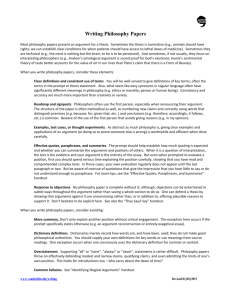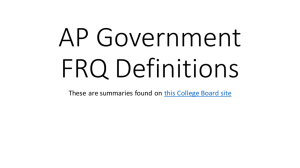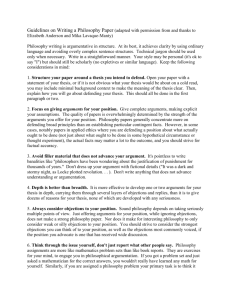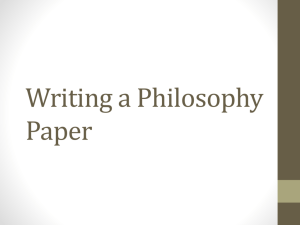Writing a Philosophy Paper
advertisement
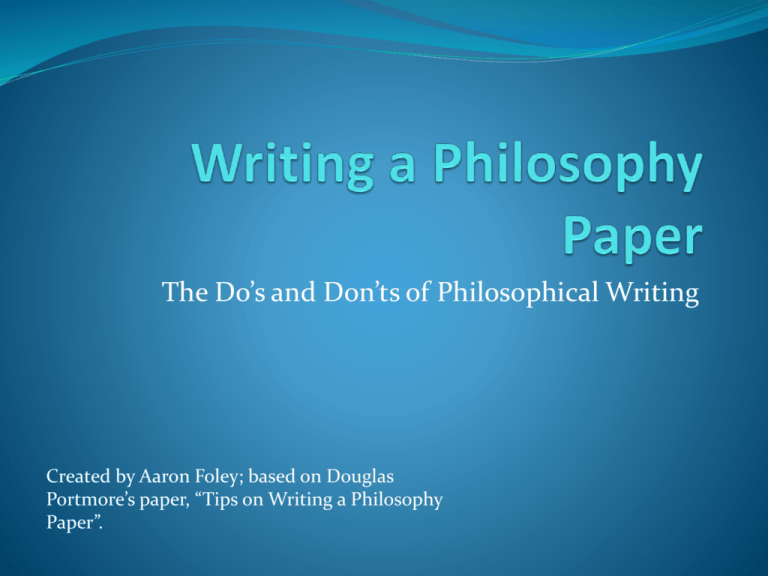
The Do’s and Don’ts of Philosophical Writing Created by Aaron Foley; based on Douglas Portmore’s paper, “Tips on Writing a Philosophy Paper”. Thesis Statement Be specific Narrow enough to be effective in length requirements Make interesting claim which can be refuted Provide “hint” of what main argument will be A Bad Thesis I will argue that utilitarianism is the most plausible moral theory. Problem: Too ambitious. In order to defend properly, you will need to examine the entire scope of not just utilitarianism, but also ethics in general. This will take roughly 100,000 full length books to accomplish. You’re not that smart. Another Bad Thesis I will discuss objections to moral objectivism. Problem: You must not just state objectives (or arguments in favor of); you must also present your position on the subject. Besides, moral objectivism is again, too ambitious. Another Bad Thesis I believe that the divine command theory is an improbable moral theory. Problem: This only states what one believes. It does not assert anything about the plausibility of the theory. A thesis must make an assertion about the issue at hand, not merely state one’s belief. Another Bad Thesis I believe that abortion is wrong. Problem: Not nearly specific enough. You must explain why you think it is wrong. Another Bad Thesis I will argue that donating our surplus income to hunger relief organizations would result in more deaths and more suffering. Problem: Empirical issue, not philosophical one. A Good Thesis I will argue that even if the fetus is a person with a right to life, abortion is, nevertheless, morally permissible in the case of rape, for the fetus has no right to use the womanʹs body without, at least, her tacit consent, and this is clearly absent where the woman is pregnant as a result of being raped. Benefits: Specific and narrow. You do not have to address any issue of abortion other than instances of rape. Another Good Thesis I will argue that Thomsonʹs argument isn’t cogent. I will demonstrate that there are important differences between killing the violinist (in her Famous Violinist Example) and killing a fetus that has been conceived as result of rape. These differences undermine her argument by analogy for the permissibility of abortion in the case of rape. Benefits: You don’t have to make any positive assertion. A thesis that asserts that some philosophical position is false or that some philosopher’s argument is unsound is an interesting and important thesis. Another Good Thesis I will argue that Arthurʹs criticisms fail to undermine Singerʹs central thesis: that we are morally obligated to donate our surplus income to hunger‐relief organizations. I will show that Singer can rebut Arthur’s objections by…. Benefits: Even if you agree entirely with one of the philosophers that you’ve read, you can still have something original and important to say. For instance, you could show how that philosopher might rebut criticisms from another. Another Good Thesis I will argue that Singerʹs thesis needs to be revised in light of Arthurʹs criticisms, but only slightly. I will propose the following revised version of Singerʹs thesis…. And I will argue that this revised version of Singer’s thesis avoids Arthurʹs objections. Lastly, I will defend this revised thesis against other potential objections. Benefits: If you can’t see anyway to defend a thesis in its current form, you might suggest how that thesis could be revised so as to avoid the objections leveled by another. Introduction Be concise Contain a clear thesis Introduce topic and explain why it is important (same as EE) Get to the point Example of Good Introduction We will be concerned with both the moral status of abortion, which for our purposes we may define as the act which a woman performs in voluntarily terminating, or allowing another person to terminate, her pregnancy, and the legal status which is appropriate for this act. I will argue that, while it is not possible to produce a satisfactory defense of a womanʹs right to obtain an abortion without showing that a fetus is not a human being, in the morally relevant sense of that term, we ought not to conclude that the difficulties involved in determining whether or not a fetus is human make it impossible to produce any satisfactory solution to the problem of the moral status of abortion. For it is possible to show that, on the basis of intuitions which we may expect even the opponents of abortion to share, a fetus is not a person, and hence not the sort of entity to which it is proper to ascribe full moral rights. Warren, Mary (1973). On the moral and legal status of abortion. The Monist 57. Body Paragraphs Exposition of the views, concepts and arguments to be discussed Your own arguments in support of your assertion Consideration of counterarguments and objections to your claim along with your response to those objections. Related to and in support of your thesis Topic Sentences Narrowly focused on one idea All sentences within that paragraph develop that narrowly focused idea Support and relate to the thesis Conclusion Restate thesis and argument Discuss implications or limitations of your thesis Address questions your argument raised Address issues your theory leaves unresolved Structure of Paragraphs Must flow logically Make an outline Use transitions List of transitions I will begin by... Before I say what is wrong with Xʹs argument, I will first... At this point, we need to consider the following objection... In this section, I will... In the next section, I will... Having argued for the view that... , I now wish to consider rival views. Although I have shown..., I still need to prove... Next, I will offer support for what is perhaps my most controversial assumption, that... I have argued that..., but someone might object... Further support for this claim comes from... Example of transitions in work ...Weʹve just seen how X says that P. I will now present two arguments that not‐P. My first argument is... My second argument is... X might respond to my arguments in several ways. For instance, he might say that... However, this response fails, because... Another way that X might respond to my arguments is to claim that... This response also fails, because... So we have seen that none of the responses open to X succeed in rebutting my argument. Hence, we should reject Xʹs claim that P. Another example of transitions in work I will argue for the view that Q. There are three reasons to accept Q. First... Second... Third... The strongest objection to Q is... However, this objection does not succeed, for the following reasons... Example of Simple Outline I. Introduction II. Singerʹs Argument for an Obligation to Assist III. Why We Should Reject His Initial Assumption IV. How Singer Might Respond V. Conclusion Structure of Sentences Repeat key words and phrases – always be consistent in your terminology – Do not be thesaurus-dependent Use pronouns Create parallel structure Use transition words Transition Words • To show addition: and, also, besides, for one, in the first case, first, second, third, finally • To offer support: because, since, for, given • To conclude: so, thus, therefore, hence, consequently, accordingly, it follows that, for this reason, from this, as a result, it would seem then • To illustrate: e.g., for example, for instance, to illustrate, a case in point • To specify: i.e., that is, viz., namely, specifically • To intensify: moreover, furthermore, mainly, principally, above all, after all, whatʹs more, more importantly • To emphasize: certainly, indeed, in fact, of course • To compare: likewise, similarly, by the same reasoning • To contrast: yet, but, rather, still, although, while, nevertheless, regardless, despite, even so, in spite of, however, whereas, even though, by contrast, on the one hand...on the other hand... • To refocus: in any case, at any rate, in a word, in short, to sum up, to return • To indicate supposition: assume, suppose, letʹs assume, letʹs suppose • To concede a point: of course, doubtless, it cannot be denied, while recognizing, the fact remains Bad Paragraph The ancient Egyptians were masters of preserving dead peopleʹs bodies by making mummies of them. Mummies several thousand years old have been discovered nearly intact. The skin, hair, teeth, fingernails and toenails, and facial features of the mummies were evident. It is possible to diagnose the disease they suffered in life, such as smallpox, arthritis, and nutritional deficiencies. The process was remarkably effective. Sometimes apparent were the fatal afflictions of the dead people: a middle‐aged king died from a blow on the head, and polio killed a child king. Mummification consisted of removing the internal organs, applying natural preservatives inside and out, and then wrapping the body in layers of bandages. Why Bad? Though weak, this paragraph is not a total washout. It starts with a topic sentence, and the sentences that follow are clearly related to the topic sentence. In the language of writing, the paragraph is unified (i.e., it contains no irrelevant details). However, the paragraph is not coherent. The sentences are disconnected from each other, making it difficult for the reader to follow the writerʹs train of thought. Bad Paragraph Done Well The ancient Egyptians were masters of preserving dead peopleʹs bodies by making mummies of them. In short, mummification consisted of removing the internal organs, applying natural preservatives inside and out, and then wrapping the body in layers of bandages. And the process was remarkably effective. Indeed, mummies several thousand years old have been discovered nearly intact. Their skin, hair, teeth, fingernails and toenails, and facial features are still evident. Their diseases in life, such as smallpox, arthritis, and nutritional deficiencies, are still diagnosable. Even their fatal afflictions are still apparent: a middle‐aged king died from a blow on the head; a child king died from polio. (Italics indicates pronouns and repeated key words, bold indicates transitional words, and underlining indicates parallel structures.) Why Done Well The paragraph is now much more coherent. The organization of the information and the links between sentences help readers move easily from one sentence to the next. Notice how this writer uses a variety of coherence devices, sometimes in combination, to achieve overall paragraph coherence. Demonstrating Mastery of Philosophical Material Do more than regurgitate material Use quotes only sparingly (and explain in detail when you do) Explain in your own words Use your own examples and arguments (i.e. do not cite someone who agrees with you) Arguing Your Position More than stating your opinions Appeal to reader’s intellect, not emotions Do not make assumptions – all arguments must be accompanied by support Criticizing an Argument Don’t treat other philosophers like idiots Respect all arguments Criticize only the strongest arguments (avoid weak arguments) Do not criticize a conclusion, but rather a specific premise of that argument Considering Potential Objections Two Types Objections to argument (directed at your reasons) Objections to thesis (directed at your conclusion) Objections to Arguments Must realize which steps of your argument opponents will criticize You will offer sub-arguments Sub-arguments are subtly more specific arguments that address the specific demands of the objection (a good idea is to use a specific hypothetical example in this case). Objections to Thesis Don’t ignore objections If you say P and Descartes says not-P, you MUST address his not-P in your essay and provide counterarguments to his not-P. Only then will you adequately support your P. Your Audience Pretend your audience has no knowledge of your topic This forces you to be clear and specific Writing Clearly and Precisely Avoid stuffy and pretentious words (alas, deem, quest, ponder, propound) Avoid long-winded sentences Use only vocabulary you use in ordinary situations (philosophy is simple and direct, not complex or obscure) Avoid metaphors – be direct Avoid overstatement (all, every, etc.) Avoid vague language Avoid ambiguity Examples of Bad Diction Calling an argument “false.” Arguments are valid or invalid, not true or false Infers vs. implies “Utilitarianism believes…” Utilitarianism is not an entity, it is a moral theory. Instead, write “Utilitarians believe” Arguing Against a Claim Reductio ad Absurdum Presenting a counter-example Reductio ad Absurdum Showing an argument implies an absurdity Example: Saying humans are more valuable than animals because they possess the ability to think intelligently. Absurd implication is that mentally retarded individuals do not possess the same value as non-retarded human beings. Presenting a Counter-Example Giving an example to prove some general proposition is false For example: Some people say we only have a duty to provide or protect those who have special relationship to us (i.e. family, friend, employer, etc). You can present “Shallow Pond” example. Child is struggling in shallow pond. With virtually no inconvenience to you (grown adult), it is a duty to save the child. Defining Your Terms Do not use dictionary definitions unless the word is very technical (i.e. a priori, prima facie, determinism, euthanasia) – no need to cite the dictionary as a source Define ordinary words if they are not precise (i.e. abortion, killing) Define ordinary words you will use with your own definition (i.e. in our discussion on “thinking thing” I asked you to define the word) Using Quotations Avoid unless absolutely necessary For example: if you need to define another philosopher’s word, you may use a direct quote For example: the quotation will be used to specifically support your argument of the text General rule of thumb – do not use quotations! Plagiarism Do not use someone else’s wording as your own Say only those things that are your own idea Do not copy anything without giving credit to the author Suggested Reading • A. P. Martinich, Philosophical Writing, 2nd ed. (Cambridge, MA: Blackwell, 1996). • Joel Feinberg and Russ Shafer‐Landau, Doing Philosophy (Belmont, CA: Wadsworth, 2001). • Stephen M. Garrison, Anthony J. Graybosch, and Gregory M. Scott, The Philosophy Student Writerʹs Manual (Englewood Cliffs, NJ: Prentice Hall, 1997). • P. Martinich, Philosophical Writing, 2nd ed. (Cambridge, MA: Blackwell, 1996). • Jay F. Rosenberg, The Practice of Philosophy: A Handbook for Beginners, 3rd ed. (Englewood Cliffs, NJ: Prentice Hall, 1995). • Zachery Seech, Writing Philosophy Papers, 3rd ed. (Belmont, CA: Wadsworth, 1997). • Colin Allen, ʺA Guide to Writing Philosophy Essays.ʺ http://snaefell.tamu.edu/~colin/Phil416/writing.html. • Istvan Berkeley, ʺHow to Write a Philosophy Paper.ʺ http://www.cariboo.bc.ca/ae/php/phil/mclaughl/courses/howrit.htm. • Barry Brown, ʺHow to Write an Essay in Bioethics.ʺ http://www.chass.utoronto.ca:8080/philosophy/phlwrite/brown1.html. • Rich Cameron, ʺThe Structure of a Typical Philosophy Paper.ʺ http://www.colorado.edu/philosophy/fac/cameron/ethics1100/ho.rfww.html. • R. L. Franklin, ʺOn Writing Philosophy Assignments.ʺ http://www.lincoln.ac.nz/emd/staff/godlovs/tips/rlfessay.htm. • James Harold, ʺOn Writing Philosophy Papers.ʺ http://www.tc.umn.edu/~harol006/paper.html. • R. W. Hepburn, ʺGood and bad in philosophy essays.ʺ http://www.arts.ed.ac.uk/philosophy/study_html/vade‐mecum/sections/section4/4‐ 1.htm. Suggested Reading (Cont) • Peter Lipton, ʺWriting Philosophy.ʺ http://www.pitt.edu/~rclifton/WritingPhilosophy.html. • Geoffrey Payzant, ʺWhat does he want?ʺ http://www.chass.utoronto.ca:8080/philosophy/phlwrite/payzant.html. • James Pryor, ʺGuidelines on Writing a Philosophy Paper.ʺ http://www.princeton.edu/~jimpryor/general/writing.html. • Evan Thompson and Duff Waring, ʺEssay Writing Handbook for Philosophy Students.ʺ http://www.yorku.ca/hjackman/Teaching/handbook.pdf. • Michael Tooley, ʺWriting a Good Ethics Essay.ʺ http://spot.colorado.edu/~tooley/WritingEssays.html. • Ellen Watson, ʺA Guide for Writing Papers in Philosophy.ʺ http://www.uq.oz.au/~pdgdunn/watessay.htm. • Martin Young, ʺUndergraduate Philosophical Writing.ʺ http://eee.uci.edu/programs/philoswr/. • Rich Cameron, ʺThe Structure of a Typical Philosophy Paper,ʺ at http://www.colorado.edu/philosophy/fac/cameron/ethics1100/ho.rfww.html. • Adam Polak, ʺEssentials of Effective Persuasive Essays,ʺ at http://spot.colorado.edu/~tooley/WritingEssays.html. • Charles Darling, Guide to Grammar and Writing, at http://webster.commnet.edu/grammar/index.htm. • Martin Young, ʺUndergraduate Philosophical Writing,ʺ at http://eee.uci.edu/programs/philoswr/. Works Cited Copyright © 2001 (Revised 2006) by Douglas W. Portmore. TIPS ON WRITING A PHILOSOPHY PAPER http://www.public.asu.edu/~dportmor/tips.pdf

